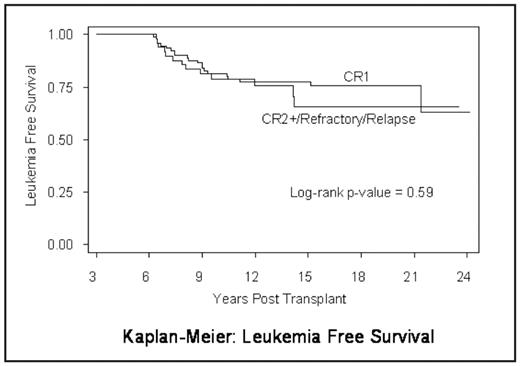Abstract
Allogeneic stem cell transplantation (ASCT) is an important curative modality for patients with acute myeloid leukemia (AML), but no large studies with mature followup after a uniform conditioning regimen and stem cell source have been reported. We previously published (
Copelan EA. Blood; 78:838–43, 1992
) the results of 127 patients with AML who underwent ASCT following preparation with oral busulfan (16 mg/kg) and cyclophosphamide (120mg/kg) (BuCy2) with a median follow-up of 3 years. We now present data on 316 AML patients, including the initial cohort, who underwent ASCT from 1984 to 1995 at 7 participating institutions the United States and Australia. All patients received bone marrow grafts from HLA-identical sibling donors following myeloablative preparation with BuCy2. One hundred fifty-seven patients were transplanted in first remission (CR1, group I), 49 in second remission (CR2, group II) and 110 patients were beyond CR2 or had refractory disease (group III). Cyclosporine or tacrolimus-based regimens were routinely administered to prevent graft-versus-host-disease (GVHD). Median follow-up of surviving patients exceeds 12 years (range 3 – 18 years). At the time of analysis 126 patients (40%) were alive. The estimated leukemia-free survival (LFS) for group I at 3 and 12 years is 63% (95% CI: 47 – 79%) and 49% (95% CI: 33 – 66%), for group II is 50% (95% CI 36 – 64%) and 33% (95% CI: 17 – 49%) and group III is 25% (95% CI: 17 – 32%) and 16% (95%CI: 8 – 24%) respectively. The estimated relapse rate for patients in group I at 3 and 12 years is 15% (95%CI: 9 – 21%) and 28% (95% CI: 20 – 36%), for group II is 38% (95% CI: 24 – 52%) and 48% (95% CI: 31 – 65%), and group III is 56% (95% CI: 4 – 68%) and 65% (95% CI: 53 – 77%). For the entire cohort (n=317), using multivariate analysis, younger age (p<0.004) and transplantation in CR1 (p<0.001) were predictive of long-term overall survival (OS) and LFS. Transplantation in CR1 (p<0.001), and presence of chronic GVHD (p=0.003) were associated with decreased risk of relapse. One hundred forty-two patients were alive and free of leukemia at 3 years; of these patients, 75% are leukemia-free survivors at 12 years. Considering only these patients, the cumulative incidence of relapse beyond 3 years was 17% and the cumulative incidence of non-relapse mortality was 9%; only 2 patients died beyond 3 years from respiratory failure. For this group, none of the factors analyzed (including age, remission status at the time of transplantation or the presence of chronic GVHD) was predictive for OS, LFS or relapse. In conclusion, although most remissions in AML patients surviving leukemia-free for at least 3 years following ASCT are durable, late relapse occurs in 17%. One in four patients alive and free of leukemia at 3 years will relapse or die from NRM over the subsequent 9 years.Disclosures: No relevant conflicts of interest to declare.
Author notes
Corresponding author
2008, The American Society of Hematology
2008


This feature is available to Subscribers Only
Sign In or Create an Account Close Modal